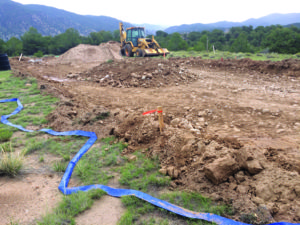By George Sibley
It’s the culmination of summer over here in the Upper Gunnison, plantwise anyway. My partner Maryo is a serious gardener, and she’s gradually weaving me into that web of life. I reached my current relatively ripe old age without learning much about growing things – something I increasingly see as a flaw in my cultural education.
But I am still useful to a gardener. For more than a decade now, we have been expanding the garden space around the house in an effort to eliminate lawn – maintaining a lawn under the desert sun is a Sisyphean task that seems entirely pointless to me. Fifty square-feet converted a year has been the goal, but we’ve laid off of that. Gardens are more work than lawns, and we’ve about maxed out on the amount of time and energy we (mostly she) can afford to put in to this labor of love, which sometimes isn’t labor one loves. Even when we get to eat the fruits of the labor; not a benefit of lawns.
So I’ve been the head shovel on the lawn conversion process; I am also good with a wheelbarrow, the device that helped humans learn to walk upright. I can also build things pretty well, so I construct the raised beds and other such projects as they arise.
One such project is a greenhouse that I built onto the south side of the house. Not a huge one – 8 by 10 feet (another 80 sq. ft. of lawn gone), big enough for five tubs of vegetables in the spring and summer. We aren’t trying to make it a year-round greenhouse; that would involve a nighttime energy investment in Gunnison that would drive the cost of a winter salad up to about ten dollars. But in the winter, it becomes our solar clothes dryer and a supplemental heat source. Around 11 a.m. on a sunny day, the greenhouse temperature goes over 100 degrees (no open vents in the winter); we open the window into the greenhouse, turn on a fan, and it replaces the furnace for the afternoon.
[InContentAdTwo]
But back to the gardens, where I am learning a lot about plants – mostly from hanging out with Maryo, doing what I’m asked to do, and either figuring out or finding out (Google) why it needs to be done.
Like pimping the cucumbers. We grow a couple cucumber plants in the greenhouse, because it’s closer to the climate they need, and it’s also easier to rig up some chicken wire for them to climb up. They do this by floating out little blind strings that feel around for something to wrap around and cling to, all the way up to and then out along the clothesline. Because we can’t count on bees or hummers to find their way into the greenhouse, we have to take care of the cucumber fertilization process.
This basically involves assisting in the performance of a sex act. Daily, after watering in the greenhouse, one of us has to closely check the cucumber vines for new female flowers, distinguished by the fact that they have a miniature cucumber at their base. When we find one, we have to pluck a male flower (no little cucumber for the guys), peel back the petals to expose the little nub of pollen-laden stamen, and gently rub that on the pistil of the female flower. If we succeed in consummating the act for the plant, then within a day or two the female’s little cucumber will start to swell – and maybe that’s enough detailed description for a family publication. But – yes, pimping the cucumbers. Not everything in the garden is that much fun.
Still, since that’s about ten minutes out of the day for two cucumber plants, one can imagine the time investment if we had to pimp for a whole cucumber farm. One begins to appreciate even more the birds and bees that do such work free – “will work for food.” We join the rest of the world’s gardeners and many of its farmers in futilely protesting the destruction of the bee populations by the mega-chemical companies. Don’t get me started on the cat-lovers who think their little pussy monster ought to run free, and what that does to the bird population.
What gets to me most about working in the garden are the mundane miracles proliferating all around that.Once the garden is up to full speed there’s hardly time to think about, because it’s all so literally overwhelming. You put a seed a little smaller than your little fingernail into the ground, and a couple months later, if you aren’t vigilant, you’ve got eighteen-inch zucchinis lurking under leaves the size of table napkins.
Where does all this – this plant stuff come from? What’s in that seed anyway? Apparently, a seed is a set of molecular instructions for creating a living shoot that will soak up a little water, root around in the soil for some very specific bits of different minerals and some carbon stuff. It will assemble those bits and pieces into a plant that will eventually produce a zucchini or a rose or an apple or a raspberry – and will also produce more seeds to perpetuate its mundane miracle.
And there’s so much of everything in even a small garden. And it all comes at once, or at any rate, over a relatively short period, too short to eat it all as it comes. Every couple days there’s another handful of beans, another bowl of tomatoes – another couple squashes, one of which ran amok under a big leaf. We give some away to neighbors who don’t see us coming (leave the two-foot zucchini on a doorstep and run); we take some to the food pantry, and try to “put up” the rest.
That’s just the edible parts, of course; there’s also the rest of the plant, which we never see in the grocery store. Maryo harvested part of the beet bed a couple days ago; when she finally had the beets ready for putting up, there was a lovely little hillock of beets – and a mountain of beet “greens,” stems and dirt in the sink. She sorted out the little tender leaves and sautéed them for dinner, but the rest went to the composters.
We have three compost bins going, and we still have to take a lot of plant matter to the tree dump. Our raised garden beds are full to overflowing with the soil we’re making in the composters; I begin to wonder what we’ll do with all our soil – start leaving a pile of old stuff by the street with a “Free” sign on it?
We realized we were limited in the amount of food we could grow by our capacity for storing it through the winter. Oh, for a root cellar! There’s a place in the backyard where we could put one, but it’s in a place where it would be difficult and destructive to bring in even a small backhoe, and it’s more digging than I’m up to anymore. We’ve tried the crawl space under the house, which has a trap door access in a closet. However, in a fit of energy awareness we had the foundation foamed a while back; the temperature down there stays mostly above fifty degrees, too warm for storing vegetables.
The alternative is preserving the food some way. The traditional – the honorable, respectable way for putting up fruits and vegetables is canning, cooking and sealing them in jars with enough heat in the process to kill all the bacteria that would otherwise break bad in the jars and kill us when we ate the contents. This is a major kind of a kitchen project, a serious undertaking that requires a fair amount of equipment as well as a lot of glass jars. So what we’re doing instead, I’m a little embarrassed to say, is blanching them (a couple minutes in boiling water, then immersion in cold water) – then freezing them in plastic baggies.
I put up the monster zucchinis in the form of zucchini bread, which freezes nicely. I’m experimenting with how high one can push the zucchini-to-flour ratio. All the recipes I’ve found use more flour than zucchini, which seems to defeat the purpose of using up zucchinis. My experiment to date shows that six parts zucchini to five parts flour gives a nice moist bread that holds together. Seven parts to five wants to fall apart a little. Don’t try eight to five.
In another couple weeks, the freezer in the back room will be full and it’ll all be over for the year. Except for the potatoes we won’t dig until late fall – about the same time the garden catalogs start coming, and Maryo starts envisioning next year’s mundane miracles in the gardens. Right now, the garden feels a little overwhelming, but I’m learning the larger truth: Hang with anything that can make so much from so little.
George Sibley lives in Gunnison where we don’t know whether the July frost is the last one of last winter or the first one of next winter.


